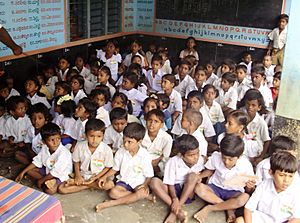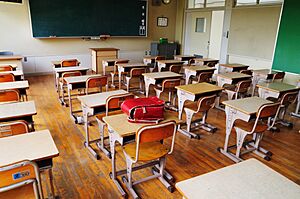Primary school facts for kids
A primary school (also called an elementary school) is where children usually go to learn between the ages of about five and eleven. It's the first big step in their education after preschool or kindergarten. After primary school, students typically move on to secondary school.
Contents
What is Primary School?
Primary school is a very important part of a child's journey in learning. It helps them build strong foundations in reading, writing, and math. It also teaches them how to get along with others and explore new ideas. The exact age when kids start and finish primary school can be a little different depending on the country.
Primary School Around the World
The way primary school works can change quite a bit from one country to another. Let's look at some examples!
Primary School in the UK
In the United Kingdom, a primary school often includes a nursery class for very young children. After nursery, children typically spend their first seven years of full-time learning here. This means they usually start around age four or five and finish around age eleven.
Primary School in the USA and Australia
In Australia and the United States, primary school usually starts with kindergarten. This is often for children around five years old. After kindergarten, students go through about six more years of school, usually until the fifth or sixth grade. In the U.S., "elementary school" is a very common name for public schools. "Primary school" is sometimes used for private schools, which are schools that don't get money from the government.
Primary School in India
In India, "Primary Education" includes 'Nursery' and 'Kindergarten' classes, followed by four years of regular schooling. Children can join Nursery classes when they are around two years old. This means they are usually six years old when they enter Class 1.
In primary school, children learn important skills like language (their mother tongue and English), reading, and writing. They also learn basic arithmetic (math) and lots of general information. This includes facts about their country, famous people, flora (plants), and animals.
However, schools in cities often have Nursery and Kindergarten, while schools in rural areas might not. Rural schools usually start directly at Class 1 when a child is six. Also, rural schools often teach only in the local language, not English. Good news: primary education is free in government schools in India! Many rural primary schools even offer free mid-day meals. This helps more children stay in school and learn. States like West Bengal, Maharashtra, Manipur, Nagaland, and Kerala have done a great job helping primary education reach more kids.
Primary School in Singapore
In Singapore, primary school is for students who are usually between 7 and 12 years old. The grades are called P1 to P6 (Primary 1 to Primary 6). At the end of P6, students take a big national test called the Primary School Leaving Exam (PSLE). The results of this test help decide which secondary school they will go to. Before primary school, children usually attend Kindergarten for two years.
Primary School in Germany
In Germany, primary school is called "Grundschule." It usually goes from first grade to fourth grade, so it's for children who are between six and ten years old. In some eastern parts of Germany, like Berlin, primary school can go up to age 12.
Most German children start learning English in third grade, but it's usually at a very basic level. They learn things like how to count and the names of colors. By the time they finish primary school, they might not be able to make full English sentences yet.
Primary school in Germany helps prepare students for secondary education. The main subjects are Math, German, and General Knowledge ("Sachkunde"). In General Knowledge, kids learn about nature, their own bodies, how to ride a bicycle safely, and facts about their city and Germany. They also have fun subjects like art, music, and Physical Education (sports).
Related pages
Images for kids
See also
 In Spanish: Educación primaria para niños
In Spanish: Educación primaria para niños












